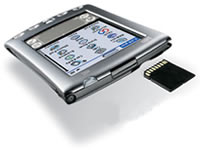 |
|
|
|
The Palm m515 handheld It had been a "panic week" of integrating a full version of an electronic medical record into our mobile IT solution. Our clinicians, who were responsible for large geographic districts and who had lots of patients, ran out of onboard memory on their 8 MB devices - all at the same time! I called Palm and told them I needed 100, 16 MB devices. They said they could send me a prototype of the m515 but the units would not be available until the 4th of March- one week later. So, I took them up on their generous offer, and solved a programming problem without having to use an expansion card.
So now I'm going to take a look at the device I have and write you a review on the spot ...probably not the best review you've ever read and certainly not based on any comparative data except my own. The m515 looks exactly like the m505. Its distinguishing features are that it has 16 MB of RAM, has a SD/MMC slot, and a much brighter display than the m500 series. The 16 bit color screen is not a high resolution screen, and is roughly comparable to the screen on the Palm IIIc. However the screen is much brighter than the m505. It runs on Palm OS v. 4.1. Size and weight: 4.5" X 3.1" X 0.5", 4.9 oz. It comes with a USB connector and a CD ROM with extra software including DataViz, a reader, AvantGo, mobile connectivity software, and an upgraded calculator. Now, here comes the real unscientific part. I used the m515 for clinical documentation practice for a total of 3 hours. (This is not an unusual amount of time for a clinician to spend using a handheld- not in one sitting, but total time/day). Then, I compared a similar exercise on a Sony Clie. My purpose in using those two devices was to compare the effect of the screen resolution on my eyes. Despite the incredible clarity of the Sony unit, I found I was less tired after using the Palm m515. The brightness and the boldness of the print seemed to be easier to read for serious and extensive use. The battery life of the m515 is also impressive. Using clinical applications that require a great deal of processing typically drain battery life in 2 days, instead of the 2 weeks you might expect from PIM-type usage. I found the battery life of the m515 almost twice as long as the m505, an earlier version in the same Palm series. For my organization's purposes, the m515 would be a good upgrade choice if it weren't so different in shape from our existing PDAs, thus requiring a full replacement of all of our peripherals. This is a problem not specific to the m515, but an annoyance just the same, as is the continually changing case, cradle, and stylus configurations. I have a pile of styli (plural for stylus?) on my desk that is starting to look like an ongoing game of pickup sticks. Each handheld (I am embarrassed to tell you how many different devices I have .... I am a incurable gadget junkie!) seems to need a different stylus shape and thickness. It would take me twenty minutes to figure out which one goes to what device. So, I end up using the back-end of a ball point, or worse yet, my fingernail, to navigate around the applications. However, this irritation is less serious than the need to continually match up keyboards and other hardware add-ons in order to keep our clinicians equipped with the best we can afford. With over 250 devices in the field, upgrading always seems to require the need to buy a second round of keyboards and/or memory expansion modules as well, and is a true expense barrier. We like the 16 MB of RAM as we can not place all of our clinical documentation software in the standard 8 MB units on the market. The price of almost $400 for the m515 seems a bit steep at the moment, and I'd rather wait to upgrade until we can get the new wireless i705 series with additional features that are due out later this year. Jeneane A. Brian is a regular contributor at PDA cortex and will
be delivering the keynote address at IMICH
2002. Jeneane Brian can be reached via email For current pricing and availability information on the Palm m515 click here
|
||||||||

